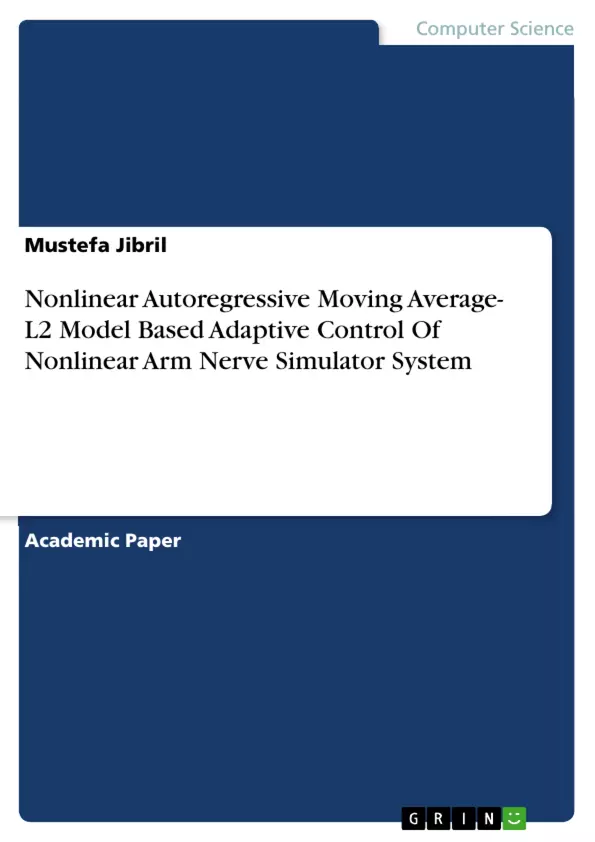This paper considers the trouble of the usage of approximate strategies for realizing the neural controllers for nonlinear SISO systems. In this paper, we introduce the nonlinear autoregressive moving average (NARMA-L2) model which might be approximations to the NARMA model. The nonlinear autoregressive moving average (NARMA-L2) model is a precise illustration of the input–output behavior of finite-dimensional nonlinear discrete time dynamical systems in a neighborhood of the equilibrium state. However, it is not always handy for purposes of neural networks due to its nonlinear dependence on the manipulate input.
In this paper, nerves system-based arm position sensor device is used to degree the precise arm function for nerve patients the use of the proposed systems. In this paper, neural network controller is designed with NARMA-L2 model, neural network controller is designed with NARMA-L2 model system identification based predictive controller and neural network controller is designed with NARMA-L2 model based model reference adaptive control system. Hence, quite regularly, approximate techniques are used for figuring out the neural controllers to conquer computational complexity.
Comparison were made among the neural network controller with NARMA-L2 model, neural network controller with NARMA-L2 model system identification based predictive controller and neural network controller with NARMA-L2 model reference based adaptive control for the preferred input arm function (step, sine wave and random signals). The comparative simulation result shows the effectiveness of the system with a neural network controller with NARMA-L2 model-based model reference adaptive control system.
Inhaltsverzeichnis (Table of Contents)
- I. INTRODUCTION
- II. SYSTEM DISCRIPTION
- A. Nerves System Based Arm Position Sensor System Description
- B. Design of NARMA-L2 Neural Network Controller
- 1) Identification of the NARMA-L2 Model:
- C. Design of NARMA-L2 Model Controller Using System Identification
- 1) System Identification:
- 2) Predictive Control:
- D. Design of NARMA-L2 Model Controller Using Adaptive Control
- III. RESULT AND DISSCUSION
- A. Comparison of the Proposed Controllers using step input signal
- B. Comparison of the Proposed Controllers using Sine Wave Input Signal
- C. Comparison of the Proposed Controllers using Random Input Signal
- D. Numerical Value Comparison of the proposed systems
- IV. CONCLUSION
Zielsetzung und Themenschwerpunkte (Objectives and Key Themes)
This paper investigates the application of approximate strategies for developing neural controllers for nonlinear single-input single-output (SISO) systems. The study focuses on the nonlinear autoregressive moving average (NARMA-L2) model as a potential approximation to the NARMA model, aiming to improve the design of neural network controllers for nerve-system-based arm position sensor devices. The objective is to develop a controller that accurately and efficiently regulates arm function for nerve patients, while addressing computational complexity.
- Modeling of nonlinear systems using the NARMA-L2 model
- Neural network controller design for arm position control
- Comparison of different control strategies based on NARMA-L2 model
- Application of adaptive and predictive control techniques
- Performance evaluation of proposed systems for different input signals
Zusammenfassung der Kapitel (Chapter Summaries)
- I. INTRODUCTION: This chapter provides an overview of the research problem, highlighting the challenges of designing neural controllers for nonlinear SISO systems. It introduces the NARMA-L2 model and its potential application for system identification and control.
- II. SYSTEM DISCRIPTION: This chapter describes the nerve-system-based arm position sensor system. It details the system's mathematical model and presents the block diagram of the device. This section also outlines the design principles of the NARMA-L2 neural network controller and its identification process.
- III. RESULT AND DISSCUSION: This chapter presents the results of simulations comparing the performance of three proposed controllers: a neural network controller with a NARMA-L2 model, a neural network controller with NARMA-L2 model system identification based predictive controller, and a neural network controller with NARMA-L2 model based model reference adaptive control. The comparison is conducted using step, sine wave, and random input signals to evaluate the effectiveness of each controller in regulating arm function.
Schlüsselwörter (Keywords)
This paper focuses on the application of nonlinear autoregressive moving average (NARMA-L2) models for neural network control of nonlinear systems. Key concepts include system identification, model reference adaptive control, predictive control, neural network implementation, and arm position sensor device for nerve patients.
- Arbeit zitieren
- Mustefa Jibril (Autor:in), 2020, Nonlinear Autoregressive Moving Average- L2 Model Based Adaptive Control Of Nonlinear Arm Nerve Simulator System, München, GRIN Verlag, https://www.hausarbeiten.de/document/542072


